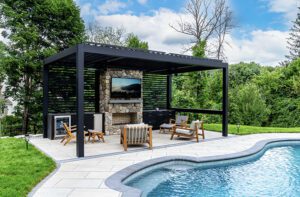Splendor In the Grass
June 20, 2016
A garden pavilion in the neoclassical style makes a gracious addition to a Chestnut Hill, Massachusetts, property.
Text by Louis Postel Photography by Richard Mandelkorn Produced by Kyle Hoepner
The owners of a large, 1920s Federal-style home in Chestnut Hill, Massachusetts, certainly felt lucky to live in a dwelling designed by William Perry, the architect behind the restoration of Colonial Williamsburg. They discovered one drawback, however: the living room sometimes felt too somber, dark, and formal.
What to do? Here’s how architect Ivan Bereznicki and interior designer Susan Reddick rectified the situation beyond anyone’s expectations. They created a separate building opposite the house, a garden pavilion situated at the end of a bluestone path set in the lawn. The 2,800-square-foot sandstone structure has understated Palladian proportions that make it seem like it’s always been there, though everything about it is new.
“The owners and I went on a sort of world tour of architecture before we decided on what kind of garden structure to make—from something Japanese to Frank Lloyd Wright,” Bereznicki relates. “Then one of them saw a pavilion in London’s Burlington Arcade suggestive of the neoclassical style of the late Edwin Lutyens and the Venetian villas of Andrea Palladio of the sixteenth century.”
The multitude of arched doors are the first thing one notices about the building. “But when you approach them,” Bereznicki explains, “you realize there’s a musical rhythm happening, an ABBA with the A’s being the smaller doors situated to the left and right of the front elevation, and ABA on the side.”
Rhythm or not, the owners were concerned that Bereznicki’s blueprints were scaled too large for the site. That’s where the ABBA rhythm played its part in convincing them otherwise. “We had a mockup done in plywood,” says Bereznicki, “and not just the facades but all the openings. Without the openings it would indeed have felt out of scale.”
Bereznicki strove to honor Palladio’s spirit without creating a carbon copy of his work. “Unlike so many overdone, flashy houses today, Palladio’s were very refined,” the architect says. “For him, everything was about modulation and moderation, a precise layering of opening and sheltering elements. Like other Renaissance masters, he believed that all design should relate to the human figure. In other words, a building should be more like a sleek Olympic swimmer than a bodybuilder on steroids flexing his oversized pecs.”
The construction, overseen by builder Michael Alberino, used certain technologies that were far different from anything Lutyens or Palladio could imagine. Rather than teams of craftsmen laboring away with chisels to shape the sandstone, it was cut by computerized saws in Ontario, Canada, arriving in Chestnut Hill like a big jigsaw puzzle. Then Bereznicki had the slabs hung from a steel frame to form the building’s facade, just as one would hang paintings.
Interior designer Susan Reddick grew up in England, where she has fond memories of running around her father’s cricket pavilion. “The Chestnut Hill pavilion is more multifunctional than just a place to break from bats and balls,” she says. “It’s beautiful year-round, night and day, a space in which you don’t have to shout to be heard if there are just two having breakfast. But when you add leaves to the center table you can comfortably seat twenty at dinner. There’s even a catering kitchen in the back for just that purpose.”
Reddick’s program brings out Bereznicki’s ABBA rhythms, but from the inside, looking out. She arranged three seating groups before the three arched doors and directly below the three leaded-glass skylights. She kept the furniture flat-backed and low enough not to interrupt the views of landscape designer Rick Lamb’s artistry.
“But too much horizontality can be monotonous,” says Reddick, so she broke things up with the vertical hump on a camelback sofa. This rise, in turn, joins a pair of soaring, fluted columns and one of a pair of ficus trees in Poterie de la Madeleine containers from Winston Flowers.
Reddick’s furnishings capture the unfussy, clean-lined spirit of the eighteenth-century neoclassic style. The little Gustavian armchairs from John Rosselli, for example, have delicately tapered arms and legs that align with the architecture, but they also offer modern comfort.
The woven backs of the dining chairs from Minton-Spidell, the pale flooring of French limestone (with radiant heat in winter), the sky-blue upholstery, the soft tones of the Afghan rug—all contribute to the airiness of the space to make a welcome retreat from the formality of the big house across the lawn. •
Share
![NEH-Logo_Black[1] NEH-Logo_Black[1]](https://b2915716.smushcdn.com/2915716/wp-content/uploads/2022/08/NEH-Logo_Black1-300x162.jpg?lossy=1&strip=1&webp=1)














You must be logged in to post a comment.